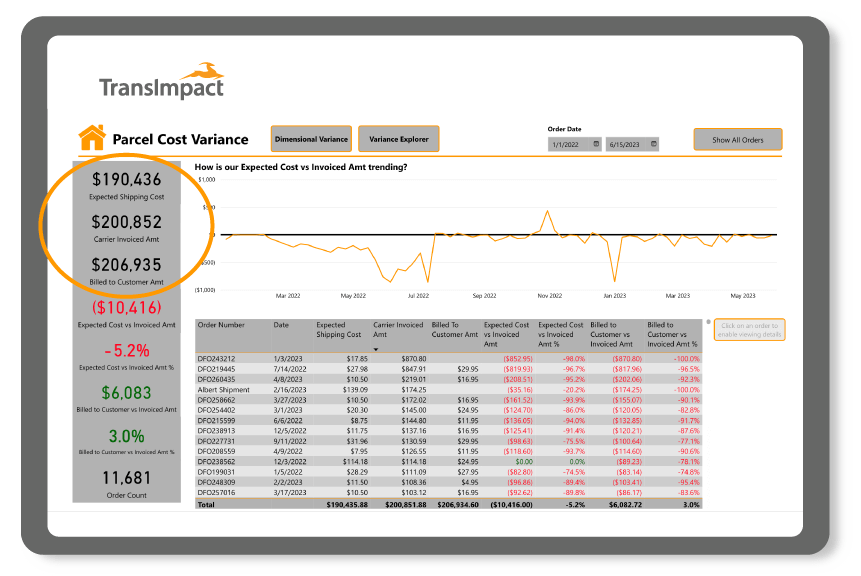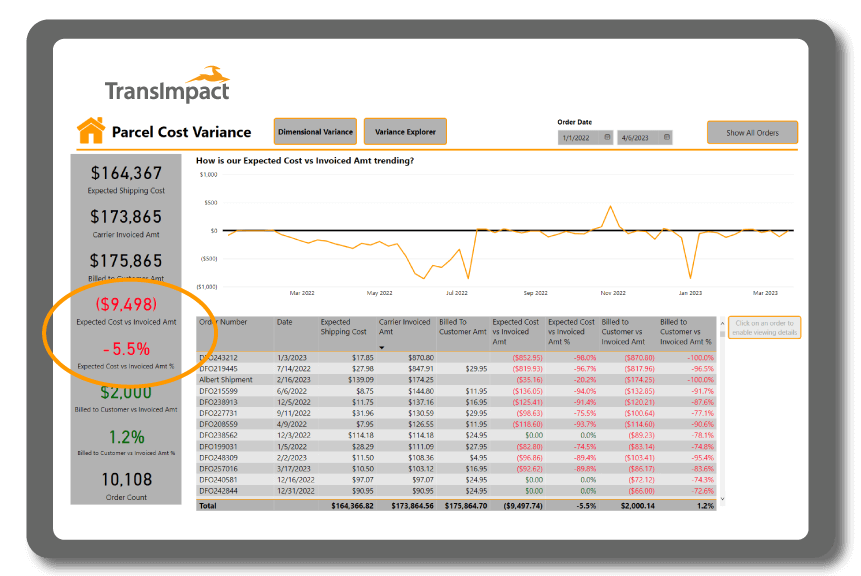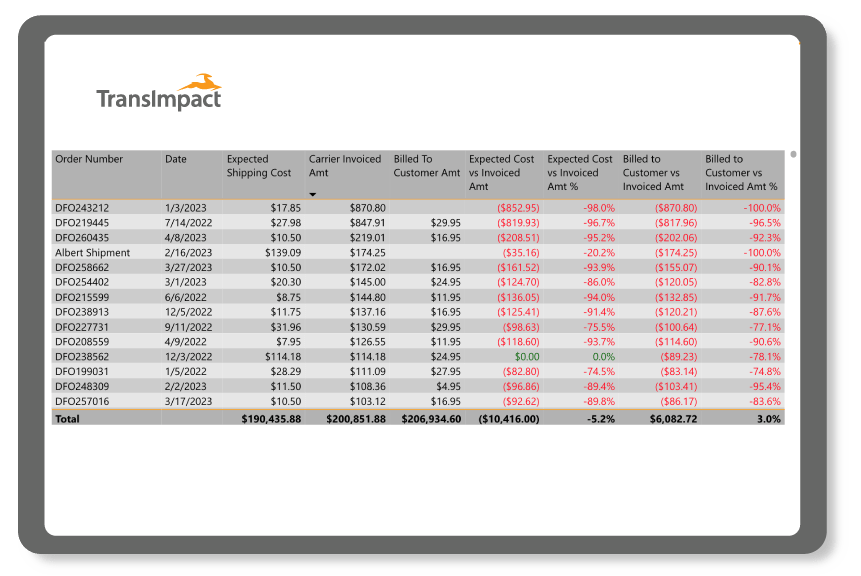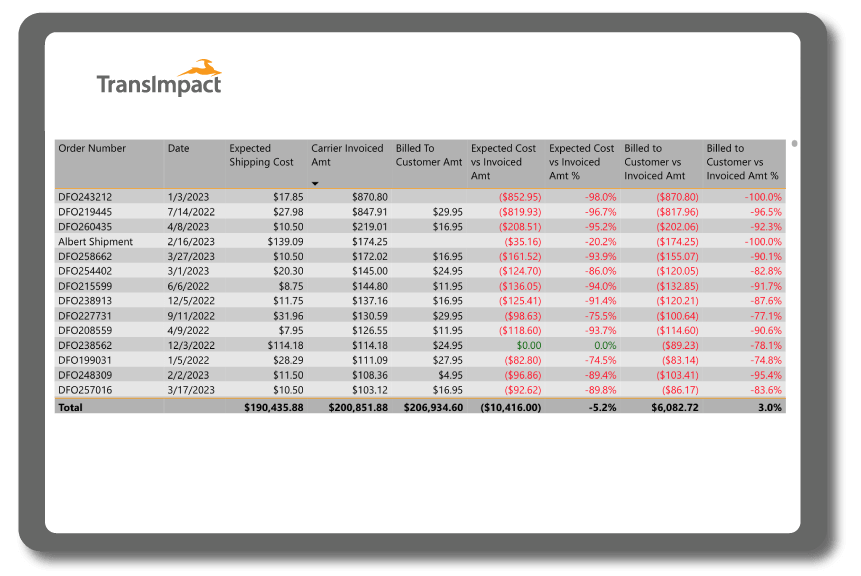Home > Parcel Spend Management > Parcel Cost Variance
Parcel Cost
Variance
Are your actual parcel costs not
aligning with your expected costs?
aligning with your expected costs?

Expected Parcel Costs
-

Actual Parcel Costs
=
![Parcel Cost Variance]](https://transimpact.com/wp-content/uploads/2023/06/Section-2-3.png)
Parcel Cost Variance
PARCEL COST VARIANCE
Savings are just a
few clicks away.
Dashboards provide everything from an executive overview
to drilling down by individual invoice or shipment.
PARCEL COST VARIANCE
View Total
Shipping Costs
in Seconds
With Parcel Cost Variance, you can
see your total shipping costs in
seconds. From expected costs to the
carrier invoice amount, and even how
much you billed your customers
for shipping.
see your total shipping costs in
seconds. From expected costs to the
carrier invoice amount, and even how
much you billed your customers
for shipping.


PARCEL COST VARIANCE
Total Expected
Cost vs. Invoiced
Amount
Parcel Cost Variance also provides your
total expected cost vs. invoiced amount
difference by amount and percentage,
as well as order count and billed to customer total vs. invoiced amount.
total expected cost vs. invoiced amount
difference by amount and percentage,
as well as order count and billed to customer total vs. invoiced amount.
You can view total parcel costs at a
glance or you can drill down to the
package-level detail to find what is
responsible for unexpected costs in
under five clicks.
glance or you can drill down to the
package-level detail to find what is
responsible for unexpected costs in
under five clicks.
PARCEL COST VARIANCE
Manifest Data
and Carrier Invoice, Together
in One Spot
The manifests you receive from your
carriers are incredibly valuable, but is
your business equipped to utilize
that data to its full potential?
carriers are incredibly valuable, but is
your business equipped to utilize
that data to its full potential?
On its own, a shipping manifest is
nothing more than a list of your
shipments. Together with your
carrier invoice, you can expose areas
of opportunity that can save you
hundreds of thousands of dollars.
nothing more than a list of your
shipments. Together with your
carrier invoice, you can expose areas
of opportunity that can save you
hundreds of thousands of dollars.


PARCEL COST VARIANCE
Stop Wasting
Hours Combing
Through Data
If you don’t have software that’s able
to merge your invoice and manifest
data, you’ll spend hours combing
through every detail trying to spot
the differences.
to merge your invoice and manifest
data, you’ll spend hours combing
through every detail trying to spot
the differences.
But with Parcel Cost Variance, you
can easily identify differences
between your manifest and invoice.
In just a few clicks, you can drill
down to the package-level detail to
find the origin of the cost variance.
can easily identify differences
between your manifest and invoice.
In just a few clicks, you can drill
down to the package-level detail to
find the origin of the cost variance.
Benefits
Parcel Cost Variance provides shippers instant visibility
to unexpected parcel costs.
to unexpected parcel costs.

Manifest and invoice data
in one spot

Actionable insights
at a glance.

Minimize unexpected
costs.

Clear visibility of costs.

Ability to make an immediate
impact on EBITDA.

Identify trends in
shipping costs.
PARCEL COST VARIANCE
With Parcel Cost Variance, you can…
- Compare expected shipping costs to carrier invoice amount.
- Compare shipping costs billed to carrier invoice amount.
- Compare shipping costs by percentage.
- View monthly parcel cost variance trends.
- Discover the root of the additional charges.
- Select order number and break down into package level details.
- Marry your manifest data with your invoice data.
Looking for Business Intelligence
that Analyzes Parcel Margin and
Sales Order Data?
Check out our Parcel Margin Analysis.
Frequently Asked Questions
Why is Parcel Cost Variance an Add-On?
Parcel Cost Variance is an add-on to your Parcel Spend Intelligence subscription. Our Parcel Spend Intelligence is an industry-leading software helping shippers optimize their parcel shipping.
Some shippers don’t need parcel cost variance because they don’t print shipping labels, while others might struggle to recover the data to make it worth their money. This is why we make it optional for you.
Parcel Cost Variance must obtain data from the shipper and requires additional resources, so it does require an integration fee, as well as a slight increase in your subscription cost.
Parcel Cost Variance must obtain data from the shipper and requires additional resources, so it does require an integration fee, as well as a slight increase in your subscription cost.
Where does Parcel Cost Variance get its data?
Parcel Cost Variance can connect to most online shipping systems (TMS, parcel shipping systems, etc.) and get the data needed directly from that system. You can also manually send the data to Parcel Spend Intelligence via email or data drop if you do not have an online system.
I ship mostly with FedEx, do I need Parcel Cost Variance?
Parcel Cost Variance provides the greatest value to FedEx shippers. FedEx does not provide the quoted package price on their final invoice. This means that some shippers aren’t even aware their final price is significantly higher than the quoted shipping cost.
With Parcel Cost Variance, shippers can expose packages that were billed incorrectly by FedEx and be able to compare what the carrier quoted and what the carrier eventually charged.
With Parcel Cost Variance, shippers can expose packages that were billed incorrectly by FedEx and be able to compare what the carrier quoted and what the carrier eventually charged.
I ship mostly with UPS, why would I want Parcel Cost Variance?
With UPS, Shipping charge corrections show a significant amount of variance, as UPS begins billing at the point of package pick up. Not all variance is easy to see, such as residential surcharges that get added, nor does UPS give you entered dimensions on every package shipped, just that the packages were adjusted.
Parcel Cost Variance provides UPS shippers with the best tools to expose variance on a package-by-package level, as well as collects additional package characteristics not provided by UPS in their invoice. This can shippers make smarter decisions on future shipments, as well as implement changes to prevent unnecessary additional costs.
Parcel Cost Variance provides UPS shippers with the best tools to expose variance on a package-by-package level, as well as collects additional package characteristics not provided by UPS in their invoice. This can shippers make smarter decisions on future shipments, as well as implement changes to prevent unnecessary additional costs.

